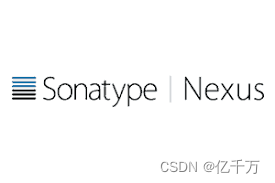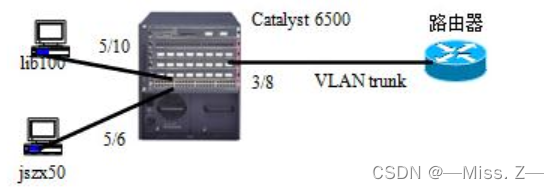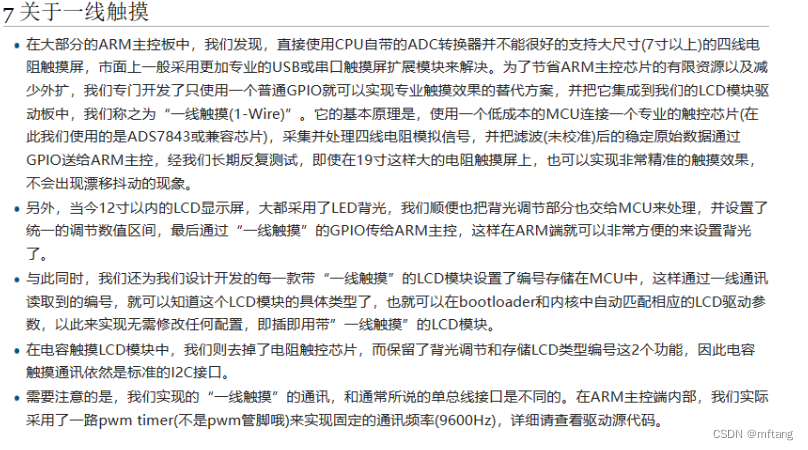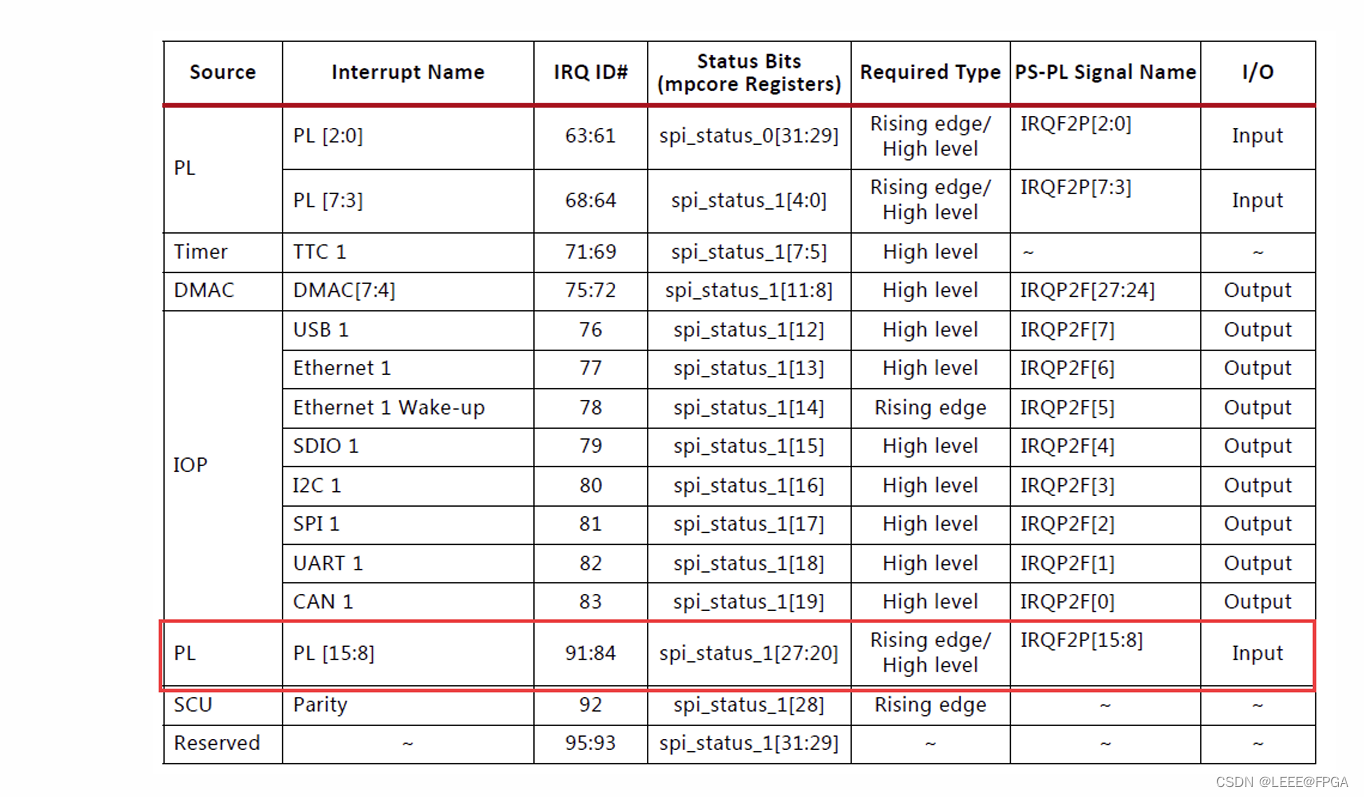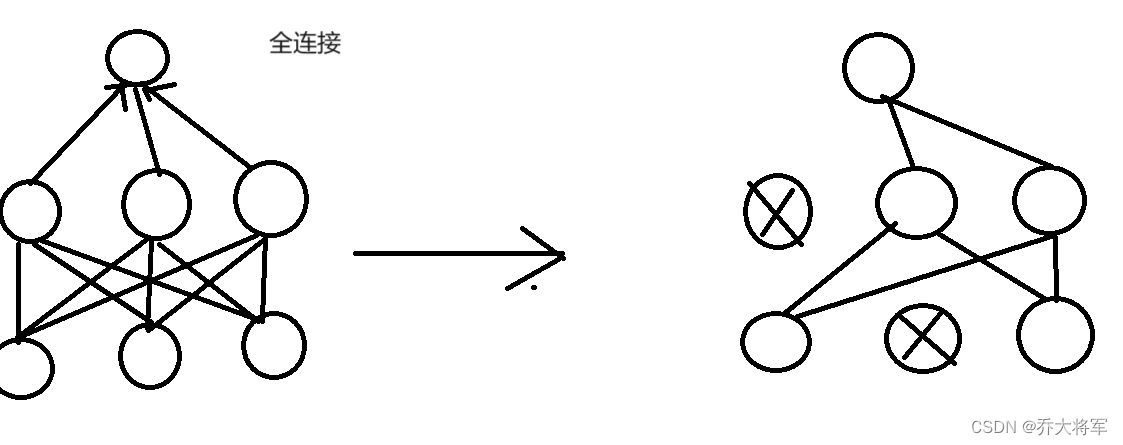Why Data Mining? • The Explosive Growth of Data: from terabytes to petabytes — Data collection and data availability ◦ Automated data collection tools, database systems, Web, computerized society — Major sources of abundant data ◦ Business: Web, e-commerce, transactions, stocks, . . . ◦ Science: Remote sensing, bioinformatics, scientific simulation, . . . ◦ Society and everyone: news, digital cameras, YouTube • We are drowning in data, but starving for knowledge! • “Necessity is the mother of invention” – Data mining—Automated analysis of massive data sets
What Is Data Mining? • Data mining (knowledge discovery from data) — Extraction of interesting (non-trivial, implicit, previously unknown and potentially useful) patterns or knowledge from huge amount of data 数据挖掘(从数据中发现知识)--从海量数据中提取有趣的(非次要的、隐含的、以前未知的和潜在有用的)模式或知识- • Alternative names — Knowledge discovery (mining) in databases (KDD), knowledge extraction, data/pattern analysis, data archeology, data dredging, information harvesting, business intelligence, etc. Data mining – searching for knowledge (interesting patterns) in data.
Origins of Data Mining • Draws ideas from machine learning/AI, pattern recognition, statistics, visualization and database systems • Traditional techniques may be unsuitable due to data that is — Large-scale — High dimensional — Heterogeneous — Complex — Distributed • A key component of the emerging field of data science and data-driven discovery • Data mining: the core of knowledge discovery process A KDD Process
• Data mining: the core of knowledge discovery process A KDD Process
KDD Process: A Typical View from ML and Statistics • This is a view from typical machine learning and statistics communities 来自机器学习和统计学界的典型观点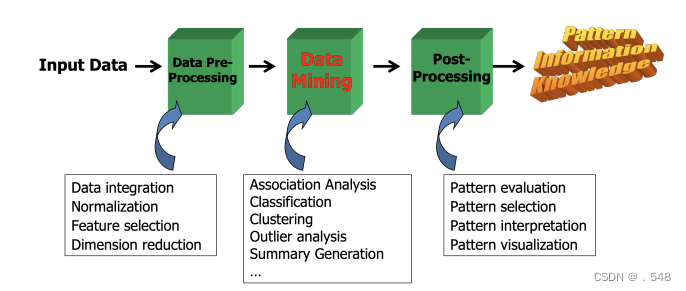 KDD Process: Several Key Steps • Learning the application domain 学习应用领域— relevant prior knowledge and goals of application • Creating a target data set创建目标数据集: data selection • Data cleaning and preprocessing数据清理和预处理: (may take 60% of effort!) • Data reduction and transformation数据缩减和转换 — Find useful features查找有用特征, dimensionality/variable reduction, invariant representation • Choosing functions of data mining选择数据挖掘功能 — summarization, classification, regression, association, clustering • Choosing the mining algorithm(s)选择挖掘算法 • Data mining: search for patterns of interest • Pattern evaluation and knowledge presentation 模式评估和知识展示— visualization, transformation, removing redundant patterns, etc. • Use of discovered knowledge
KDD Process: Several Key Steps • Learning the application domain 学习应用领域— relevant prior knowledge and goals of application • Creating a target data set创建目标数据集: data selection • Data cleaning and preprocessing数据清理和预处理: (may take 60% of effort!) • Data reduction and transformation数据缩减和转换 — Find useful features查找有用特征, dimensionality/variable reduction, invariant representation • Choosing functions of data mining选择数据挖掘功能 — summarization, classification, regression, association, clustering • Choosing the mining algorithm(s)选择挖掘算法 • Data mining: search for patterns of interest • Pattern evaluation and knowledge presentation 模式评估和知识展示— visualization, transformation, removing redundant patterns, etc. • Use of discovered knowledge
Data Mining and Business Intelligence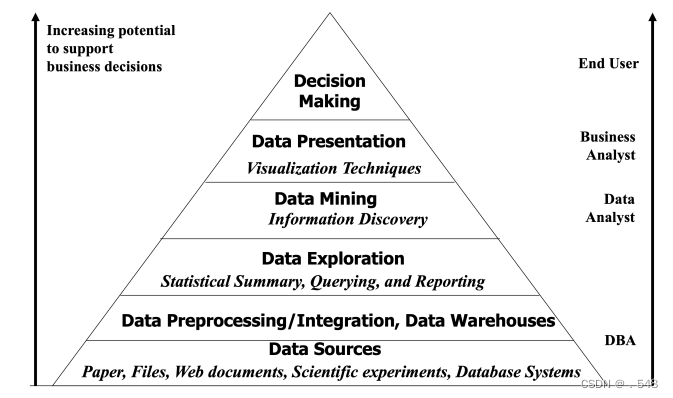
Multi-Dimensional View of Data Mining • Data to be mined — Relational, data warehouse, transactional, stream, object-oriented/relational, active, spatial, time-series, text, multi-media, heterogeneous, legacy, WWW 需要挖掘的数据 - 关系型、数据仓库型、事务型、数据流型、面向对象/关系型、活动型、空间型、时间序列型、文本型、多媒体型、异构型、遗留型、WWW• Knowledge to be mined — Characterization, discrimination, association, classification, clustering, trend/deviation, outlier analysis, etc.需要挖掘的知识 - 特征、鉴别、关联、分类、聚类、趋势/差异、异常值分析等 - 多种/集成功能和多层次挖掘 — Multiple/integrated functions and mining at multiple levels多种/集成功能和多层次挖掘 • Techniques utilized — Database-oriented, data warehouse (OLAP), machine learning, statistics, visualization, etc.使用的技术 - 面向数据库、数据仓库(OLAP)、机器学习、统计、可视化等 • Applications adapted — Retail, telecommunication, banking, fraud analysis, bio-data mining, stock market analysis, text mining, Web mining, etc.适应的应用 - 零售、电信、银行、欺诈分析、生物数据挖掘、股票市场分析、文本挖掘、网络挖掘等
Data Mining: Classification Schemes • General functionality — Descriptive data mining — Predictive data mining 一般功能 - 描述性数据挖掘 - 预测性数据挖掘• Different views lead to different classifications — Data view: Kinds of data to be mined 数据观点: 要挖掘的数据类型— Knowledge view: Kinds of knowledge to be discovered 知识观点: 有待发现的知识种类 — Method view: Kinds of techniques utilized 方法观点:使用的技术种类— Application view: Kinds of applications adapted应用观点: 适应的应用程序类型
Data Mining: On What Kinds of Data? • Database-oriented data sets and applications — Relational database, data warehouse, transactional database面向数据库的数据集和应用 - 关系数据库、数据仓库、事务数据库 • Advanced data sets and advanced applications — Data streams and sensor data — Time-series data, temporal data, sequence data (incl. bio-sequences) — Structure data, graphs, social networks and multi-linked data — Object-relational databases — Heterogeneous databases and legacy databases — Spatial data and spatiotemporal data — Multimedia database — Text databases — The World-Wide Web高级数据集和高级应用 - 数据流和传感器数据 - 时间序列数据、时间数据、序列数据(包括生物序列) - 结构数据、图形、社交网络和多链接数据 - 对象关系数据库 - 异构数据库和传统数据库 - 空间数据和时空数据 - 多媒体数据库 - 文本数据库 - 万维网 Data Mining Tasks • Prediction Methods — Use some variables to predict unknown or future values of other variables预测方法 - 使用某些变量预测其他变量的未知值或未来值 • Description Methods — Find human-interpretable patterns that describe the data; create summaries描述方法 - 找出描述数据的人类可解释模式;创建摘要
Data Mining Tasks • Prediction Methods — Use some variables to predict unknown or future values of other variables预测方法 - 使用某些变量预测其他变量的未知值或未来值 • Description Methods — Find human-interpretable patterns that describe the data; create summaries描述方法 - 找出描述数据的人类可解释模式;创建摘要
Data Mining Tasks • Classification [Predictive] • Clustering [Descriptive] • Association Rule Discovery [Descriptive] • Sequential Pattern Discovery [Descriptive] • Regression [Predictive] • Deviation Detection / Anomaly Detection [Predictive]数据挖掘任务 - 分类[预测性] - 聚类[描述性] - 关联规则发现[描述性] - 序列模式发现[描述性] - 回归[预测性] - 偏差检测/异常检测[预测性]
Data Mining Functions: (1) Generalization • Information integration and data warehouse construction — Data cleaning, transformation, integration, and multidimensional data model信息集成和数据仓库建设--数据清理、转换、集成和多维数据模型 • Data cube technology — Scalable methods for computing (i.e., materializing) multidimensional aggregates — OLAP (online analytical processing) 数据立方体技术--计算(即具体化)多维集合的可扩展方法--OLAP(在线分析处理)• Multidimensional concept description: Characterization and discrimination — Generalize, summarize, and contrast data characteristics, e.g., dry v.s. wet regions多维概念描述: 特征描述和判别 - 归纳、总结和对比数据特征,如干燥地区和潮湿地区
Data Mining Functions: (2) Association and Correlation Analysis • Frequent patterns (or frequent itemsets) — What items are frequently purchased together in your Walmart? • Association, correlation vs. causality — A typical association rule - 关联性、相关性与因果性 - 一个典型的关联规则◦ Diaper → Beer [0.5%, 75%] (support, confidence) — Are strongly associated items also strongly correlated? • How to mine such patterns and rules efficiently in large datasets? • How to use such patterns for classification, clustering, and other applications?
Association Rule Discovery: Definition • Given a set of records each of which contain some number of items from a given collection; — Produce dependency rules which will predict occurrence of an item based on occurrences of other items. 给定一组记录,其中每条记录都包含给定集合中的若干项目; - 生成依赖规则,根据其他项目的出现情况预测某个项目的出现情况 Data Mining Functions: (3) Classification and Prediction • Classification and prediction — Construct models (functions) based on some training examples — Describe and distinguish classes or concepts for future prediction ◦ e.g., classify countries based on (climate), or classify cars based on (gas mileage) 分类和预测 - 基于一些训练实例构建模型(函数) - 描述和区分类别或概念,用于未来预测 — Predict some unknown or missing numerical values 预测一些未知或缺失的数值• Typical methods — Decision trees, na¨ıve Bayesian classification, support vector machines, neural networks, rule-based classification, pattern-based classification, logistic regression, ... 典型方法 - 决策树、贝叶斯分类法、支持向量机、神经网络、基于规则的分类法、基于模式的分类法、逻辑回归法...• Typical applications — Credit card fraud detection, direct marketing, classifying stars, diseases, web-pages, ...典型应用 - 信用卡欺诈检测、直销、明星分类、疾病分类、网页分类.
Data Mining Functions: (3) Classification and Prediction • Classification and prediction — Construct models (functions) based on some training examples — Describe and distinguish classes or concepts for future prediction ◦ e.g., classify countries based on (climate), or classify cars based on (gas mileage) 分类和预测 - 基于一些训练实例构建模型(函数) - 描述和区分类别或概念,用于未来预测 — Predict some unknown or missing numerical values 预测一些未知或缺失的数值• Typical methods — Decision trees, na¨ıve Bayesian classification, support vector machines, neural networks, rule-based classification, pattern-based classification, logistic regression, ... 典型方法 - 决策树、贝叶斯分类法、支持向量机、神经网络、基于规则的分类法、基于模式的分类法、逻辑回归法...• Typical applications — Credit card fraud detection, direct marketing, classifying stars, diseases, web-pages, ...典型应用 - 信用卡欺诈检测、直销、明星分类、疾病分类、网页分类.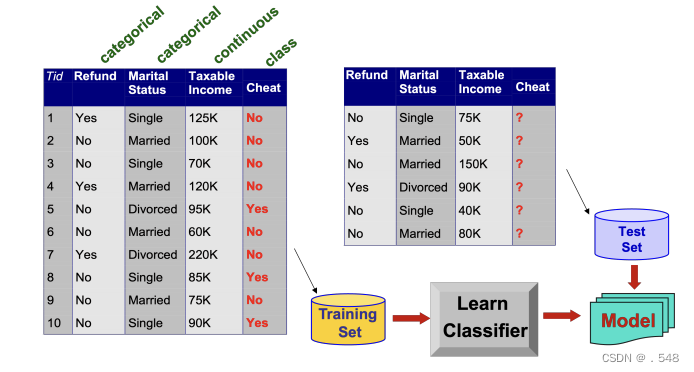 Data Mining Functions: (4) Cluster and Outlier Analysis • Cluster analysis — Unsupervised learning (i.e., Class label is unknown) — Group data to form new categories (i.e., clusters), e.g., cluster houses to find distribution patterns — Principle: Maximizing intra-class similarity & minimizing interclass similarity — Many methods and applications 聚类分析 - 无监督学习(即类标签未知) - 将数据分组以形成新的类别(即聚类),例如,聚类房屋以寻找分布模式 - 原则: 最大化类内相似性,最小化类间相似性 - 许多方法和应用 • Outlier analysis — Outlier: A data object that does not comply with the general behavior of the data — Noise or exception? – One person’s garbage could be another person’s treasure — Methods: by product of clustering or regression analysis, ... — Useful in fraud detection, rare events analysis离群值分析 - 离群值: 不符合数据一般行为的数据对象 - 噪音还是异常?- 一个人的垃圾可能是另一个人的宝藏 - 方法:聚类或回归分析的产物...... - 在欺诈检测、罕见事件分析中很有用
Data Mining Functions: (4) Cluster and Outlier Analysis • Cluster analysis — Unsupervised learning (i.e., Class label is unknown) — Group data to form new categories (i.e., clusters), e.g., cluster houses to find distribution patterns — Principle: Maximizing intra-class similarity & minimizing interclass similarity — Many methods and applications 聚类分析 - 无监督学习(即类标签未知) - 将数据分组以形成新的类别(即聚类),例如,聚类房屋以寻找分布模式 - 原则: 最大化类内相似性,最小化类间相似性 - 许多方法和应用 • Outlier analysis — Outlier: A data object that does not comply with the general behavior of the data — Noise or exception? – One person’s garbage could be another person’s treasure — Methods: by product of clustering or regression analysis, ... — Useful in fraud detection, rare events analysis离群值分析 - 离群值: 不符合数据一般行为的数据对象 - 噪音还是异常?- 一个人的垃圾可能是另一个人的宝藏 - 方法:聚类或回归分析的产物...... - 在欺诈检测、罕见事件分析中很有用
Illustrating Clustering • Euclidean Distance Based Clustering in 3-D space说明聚类--基于欧氏距离的三维空间聚类 Data Mining Functions: (5) Trend and Evolution Analysis • Sequence, trend and evolution analysis — Trend and deviation analysis: e.g., regression — Sequential pattern mining ◦ e.g., first buy digital camera, then large SD memory cards — Periodicity analysis — Motifs, time-series, and biological sequence analysis ◦ Approximate and consecutive motifs — Similarity-based analysis 序列、趋势和演变分析 - 趋势和偏差分析:如回归 - 序列模式挖掘 ◦ 如先购买数码相机,再购买大型 SD 存储卡 - 周期性分析 - 主题、时间序列和生物序列分析 ◦ 近似和连续主题 • Mining data streams — Ordered, time-varying, potentially infinite, data streams基于相似性的分析 - 挖掘数据流 - 有序、时变、可能无限的数据流
Data Mining Functions: (5) Trend and Evolution Analysis • Sequence, trend and evolution analysis — Trend and deviation analysis: e.g., regression — Sequential pattern mining ◦ e.g., first buy digital camera, then large SD memory cards — Periodicity analysis — Motifs, time-series, and biological sequence analysis ◦ Approximate and consecutive motifs — Similarity-based analysis 序列、趋势和演变分析 - 趋势和偏差分析:如回归 - 序列模式挖掘 ◦ 如先购买数码相机,再购买大型 SD 存储卡 - 周期性分析 - 主题、时间序列和生物序列分析 ◦ 近似和连续主题 • Mining data streams — Ordered, time-varying, potentially infinite, data streams基于相似性的分析 - 挖掘数据流 - 有序、时变、可能无限的数据流
Data Mining Functions: (6) Structure and Network Analysis • Graph mining — Finding frequent subgraphs (e.g., chemical compounds), trees (XML), substructures (web fragments) 图挖掘 - 寻找频繁出现的子图(如化合物)、树(XML)、子结构(网络片段)• Information network analysis — Social networks: actors (objects, nodes) and relationships (edges) 信息网络分析 - 社会网络:行为者(对象、节点)和关系(边)◦ e.g., author networks in CS, terrorist networks — Multiple heterogeneous networks ◦ A person could be multiple information networks: friends, family, classmates, ... — Links carry a lot of semantic information: Link mining • Web mining — Web is a big information network: 链接携带大量语义信息: 链接挖掘 - 网络挖掘 - 网络是一个巨大的信息网络from PageRank to Google — Analysis of Web information networks ◦ Web community discovery, opinion mining, usage mining, ...
Top-10 Algorithm Finally Selected at ICDM’ 06 1. C4.5 (61 votes) 2. K-Means (60 votes) 3. SVM (58 votes) 4. Apriori (52 votes) 5. EM (48 votes) 6. PageRank (46 votes) 7. AdaBoost (45 votes) 8. kNN (45 votes) 9. Naive Bayes (45 votes) 10. CART (34 votes)
Are All the “Discovered” Patterns Interesting? • Data mining may generate thousands of patterns: Not all of them are interesting — Suggested approach: Human-centered, query-based, focused mining数据挖掘可能会产生成千上万种模式: 并非所有模式都有趣 • Interestingness measures — A pattern is interesting if it is easily understood by humans, valid on new or test data with some degree of certainty, potentially useful, novel, or validates some hypothesis that a user seeks to confirm 建议的方法: 以人为中心、基于查询、有重点的挖掘 - 趣味性衡量标准 - 如果一个模式容易被人类理解、在新数据或测试数据上有一定程度的确定性、潜在有用、新颖或验证了用户试图确认的某些假设,那么这个模式就是有趣的 - 客观与主观趣味性衡量标准 • Objective v.s. subjective interestingness measures — Objective: based on statistics and structures of patterns, e.g., support, confidence, etc. — Subjective: based on user’s belief in the data, e.g., unexpectedness, novelty, actionability, etc.客观:基于模式的统计数据和结构,如支持度、置信度等 - 主观:基于用户对数据的信念,如意外性、新颖性、可操作性等。
Find All and Only Interesting Patterns? • Find all the interesting patterns: Completeness — Can a data mining system find all the interesting patterns? Do we need to find all of the interesting patterns? — Heuristic vs. exhaustive search — Association vs. classification vs. clustering找到所有有趣的模式: 完整性 - 数据挖掘系统能否找到所有有趣的模式?我们需要找到所有有趣的模式吗? - 启发式搜索与穷举式搜索 - 关联搜索与分类搜索与聚类搜索 • Search for only interesting patterns: An optimization problem — Can a data mining system find only the interesting patterns? — Approaches ◦ First general all the patterns and then filter out the uninteresting ones ◦ Generate only the interesting patterns – mining query optimization只搜索有趣的模式: 数据挖掘系统能否只找到有趣的模式? - 方法 ◦首先概括所有模式,然后过滤掉不有趣的模式 ◦只生成有趣的模式 - 挖掘查询优化
Other Pattern Mining Issues • Precise patterns vs. approximate patterns — Association and correlation mining: possible find sets of precise patterns ◦ But approximate patterns can be more compact and sufficient ◦ How to find high quality approximate patterns? — Gene sequence mining: approximate patterns are inherent ◦ How to derive efficient approximate pattern mining algorithms?精确模式与近似模式 - 关联和相关性挖掘:可能找到精确模式集 ◦ 但近似模式可能更紧凑、更充分 ◦ 如何找到高质量的近似模式? - 基因序列挖掘:近似模式是固有的 ◦ 如何推导出高效的近似模式挖掘算法? • Constrained vs. non-constrained patterns — Why constraint-based mining? — What are the possible kinds of constraints? How to push constraints into the mining process?精确模式与近似模式 - 关联和相关性挖掘:可能找到精确模式集 ◦ 但近似模式可能更紧凑、更充分 ◦ 如何找到高质量的近似模式? - 基因序列挖掘:近似模式是固有的 ◦ 如何推导出高效的近似模式挖掘算法?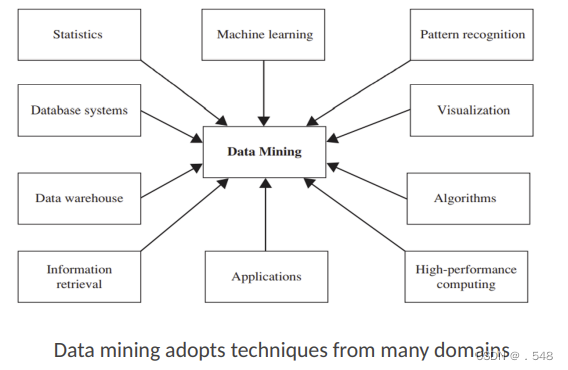
Integration of Data Mining and Data Warehousing • Data mining systems, DBMS, Data warehouse systems coupling — No coupling, loose-coupling, semi-tight-coupling, tight-coupling 数据挖掘系统、数据库管理系统、数据仓库系统的耦合--无耦合、松耦合、半紧耦合、紧耦合• On-line analytical mining data — integration of mining and OLAP technologies线分析挖掘数据--挖掘与 OLAP 技术的集成- • Interactive mining multi-level knowledge — Necessity of mining knowledge and patterns at different levels of abstraction by drilling/rolling, pivoting, slicing/dicing, etc. 交互式挖掘多层次知识--必须通过钻取/滚动、透视、切片/切割等方法挖掘不同抽象层次的知识和模式。• Integration of multiple mining functions — Characterized classification, first clustering and then association多种挖掘功能的整合 - 特征分类,先是聚类,然后是关联
Coupling Data Mining with DB/DW Systems • No coupling – flat file processing, not recommended 无耦合 - 扁平文件处理,不推荐• Loose coupling — Fetching data from DB/DW松耦合 - 从 DB/DW 获取数据 • Semi-tight coupling – enhanced DM performance — Provide efficient implement a few data mining primitives in a DB/DW system, e.g., sorting, indexing, aggregation, histogram analysis, multiway join, precomputation of some stat functions半紧密耦合 - 增强 DM 性能 - 在 DB/DW 系统中有效地实现一些数据挖掘原语,例如: 排序、索引、聚合、直方图分析、多路连接、一些统计函数的预计算 • Tight coupling – A uniform information processing environment — DM is smoothly integrated into a DB/DW system, mining query is optimized based on mining query, indexing, query processing methods, etc.紧密耦合 - 统一的信息处理环境 - 将 DM 顺利集成到 DB/DW 系统中,根据挖掘查询、索引、查询处理方法等优化挖掘查询。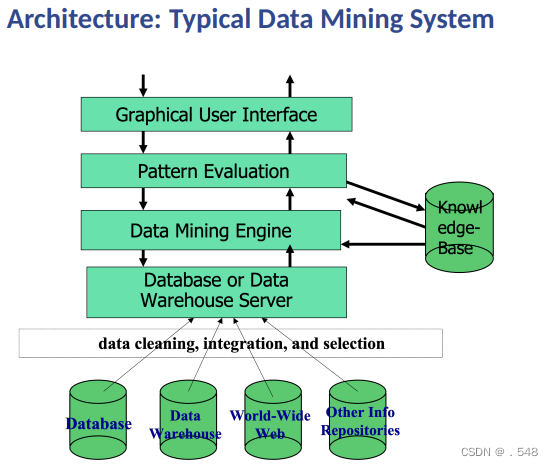
 Major Issues in Data Mining • Mining methodology — Mining different kinds of knowledge from diverse data types, e.g., bio, stream, Web — Performance: efficiency, effectiveness, and scalability — Pattern evaluation: the interestingness problem — Incorporation of background knowledge — Handling noise and incomplete data — Parallel, distributed and incremental mining methods — Integration of the discovered knowledge with existing one: knowledge fusion 数据挖掘的主要问题 - 挖掘方法 - 从不同数据类型(如生物、流、网络)中挖掘不同类型的知识 - 性能:效率、有效性和可扩展性 - 模式评估:趣味性问题 - 纳入背景知识 - 处理噪音和不完整数据 - 并行、分布式和增量挖掘 性能:效率、有效性和可扩展性 - 模式评估:趣味性问题 - 背景知识的纳入 - 噪音和不完整数据的处理 - 并行、分布式和增量挖掘方法 - 发现的知识与现有知识的整合:知识融合• User interaction — Data mining query languages and ad-hoc mining — Expression and visualization of data mining results — Interactive mining of knowledge at multiple levels of abstraction 用户交互 - 数据挖掘查询语言和临时挖掘 - 数据挖掘结果的表达和可视化 - 多层次抽象知识的交互式挖掘 • Applications and social impacts — Domain-specific data mining & invisible data mining — Protection of data security, integrity, and privacy 应用和社会影响 - 特定领域数据挖掘和隐形数据挖掘 - 数据安全性、完整性和隐私保护
Major Issues in Data Mining • Mining methodology — Mining different kinds of knowledge from diverse data types, e.g., bio, stream, Web — Performance: efficiency, effectiveness, and scalability — Pattern evaluation: the interestingness problem — Incorporation of background knowledge — Handling noise and incomplete data — Parallel, distributed and incremental mining methods — Integration of the discovered knowledge with existing one: knowledge fusion 数据挖掘的主要问题 - 挖掘方法 - 从不同数据类型(如生物、流、网络)中挖掘不同类型的知识 - 性能:效率、有效性和可扩展性 - 模式评估:趣味性问题 - 纳入背景知识 - 处理噪音和不完整数据 - 并行、分布式和增量挖掘 性能:效率、有效性和可扩展性 - 模式评估:趣味性问题 - 背景知识的纳入 - 噪音和不完整数据的处理 - 并行、分布式和增量挖掘方法 - 发现的知识与现有知识的整合:知识融合• User interaction — Data mining query languages and ad-hoc mining — Expression and visualization of data mining results — Interactive mining of knowledge at multiple levels of abstraction 用户交互 - 数据挖掘查询语言和临时挖掘 - 数据挖掘结果的表达和可视化 - 多层次抽象知识的交互式挖掘 • Applications and social impacts — Domain-specific data mining & invisible data mining — Protection of data security, integrity, and privacy 应用和社会影响 - 特定领域数据挖掘和隐形数据挖掘 - 数据安全性、完整性和隐私保护
Why Data Mining? – Potential Applications • Data analysis and decision support — Market analysis and management ◦ Target marketing, customer relationship management (CRM), market basket analysis, cross selling, market segmentation — Risk analysis and management ◦ Forecasting, customer retention, improved underwriting, quality control, competitive analysis — Fraud detection and detection of unusual patterns (outliers) • Other Applications — Text mining (news group, email, documents) and Web mining — Stream data mining — Bioinformatics and bio-data analysis潜在应用 - 数据分析和决策支持 - 市场分析和管理 ◦ 目标营销、客户关系管理 (CRM)、市场篮子分析、交叉销售、市场细分 - 风险分析和管理 ◦ 预测、客户保留、改进承保、质量控制、竞争分析 - 欺诈检测和异常模式(异常值)检测 - 其他应用 - 文本挖掘(新闻组、电子邮件、文档)和网络挖掘 - 流数据挖掘 - 生物信息学和生物数据分析
Example 1: Market Analysis and Management • Where does the data come from? – Credit card transactions, loyalty cards, discount coupons, customer complaint calls, plus (public) lifestyle studies • Target marketing — Find clusters of “model” customers who share the same characteristics: interest, income level, spending habits, etc. — Determine customer purchasing patterns over time • Cross-market analysis—Find associations/co-relations between product sales, & predict based on such association • Customer profiling—What types of customers buy what products (clustering or classification) • Customer requirement analysis — Identify the best products for different groups of customers — Predict what factors will attract new customers • Provision of summary information — Multidimensional summary reports — Statistical summary information (data central tendency and variation)
Example 1: Market Analysis and Management • Where does the data come from? – Credit card transactions, loyalty cards, discount coupons, customer complaint calls, plus (public) lifestyle studies • Target marketing — Find clusters of “model” customers who share the same characteristics: interest, income level, spending habits, etc. — Determine customer purchasing patterns over time • Cross-market analysis—Find associations/co-relations between product sales, & predict based on such association • Customer profiling—What types of customers buy what products (clustering or classification) • Customer requirement analysis — Identify the best products for different groups of customers — Predict what factors will attract new customers • Provision of summary information — Multidimensional summary reports — Statistical summary information (data central tendency and variation)
Example 3: Fraud Detection & Mining Unusual Patterns • Approaches: Clustering & model construction for frauds, outlier analysis • Applications: Health care, retail, credit card service, telecomm — Auto insurance: ring of collisions — Money laundering: suspicious monetary transactions — Medical insurance ◦ Professional patients, ring of doctors, and ring of references ◦ Unnecessary or correlated screening tests — Telecommunications: phone-call fraud ◦ Phone call model: destination of the call, duration, time of day or week. Analyze patterns that deviate from an expected norm — Retail industry ◦ Analysts estimate that 38% of retail shrink is due to dishonest employees — Anti-terrorism
Summary • Data mining: Discovering interesting patterns from large amounts of data • A natural evolution of database technology, in great demand, with wide applications • A KDD process includes data cleaning, data integration, data selection, transformation, data mining, pattern evaluation, and knowledge presentation • Mining can be performed in a variety of information repositories • Data mining functionalities: characterization, discrimination, association, classification, clustering, outlier and trend analysis, etc. • Data mining systems and architectures • Major issues in data mining数据挖掘: 从大量数据中发现有趣的模式 - 数据库技术的自然发展,需求巨大,应用广泛 - KDD 流程包括数据清理、数据整合、数据选择、转换、数据挖掘、模式评估和知识展示 - 可在各种信息库中进行挖掘 - 数据挖掘功能:特征描述、判别、关联、分类、聚类、离群值和趋势分析等。 - 数据挖掘系统和架构 - 数据挖掘的主要问题



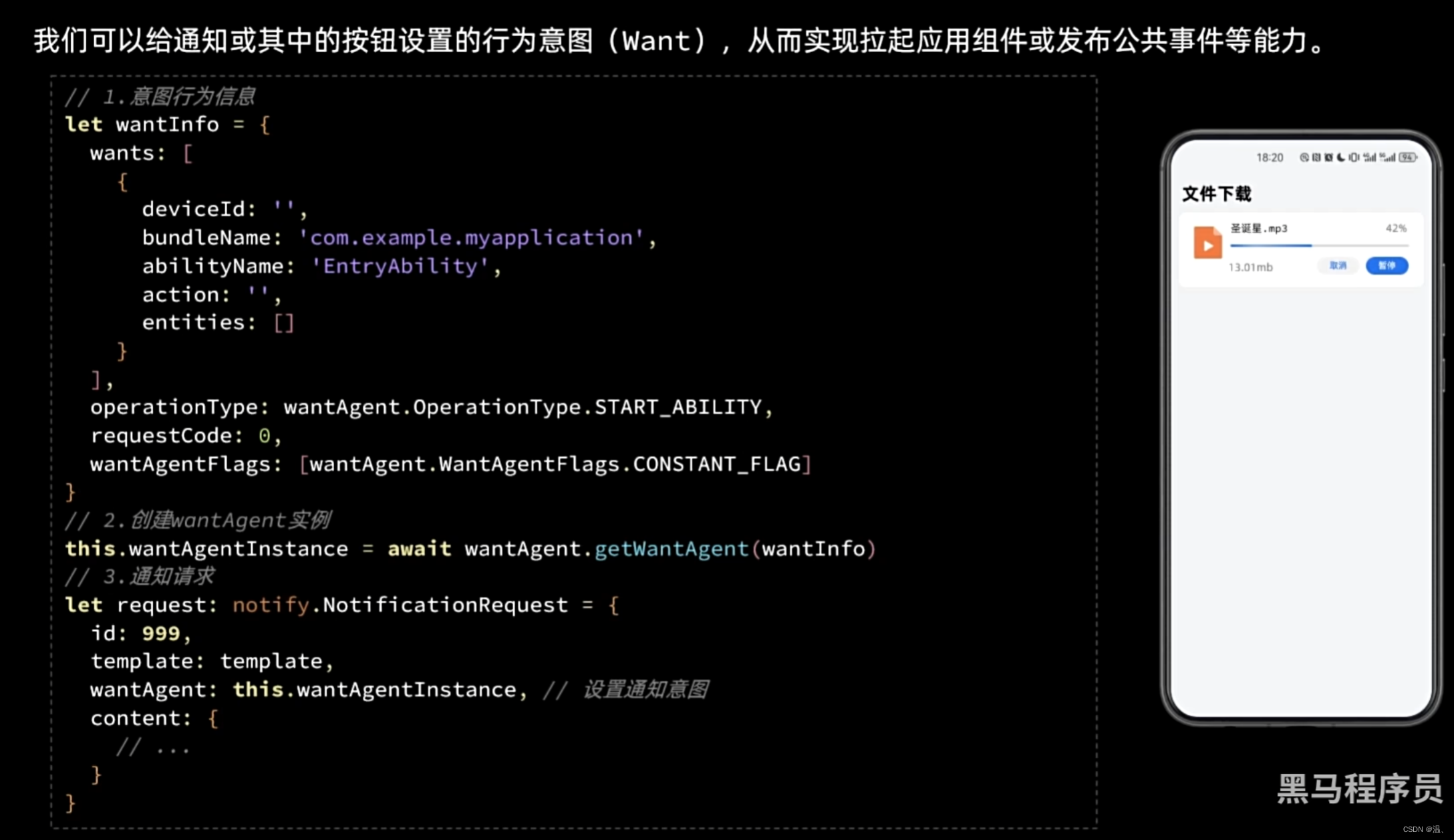


![[C语言]——内存函数](https://img-blog.csdnimg.cn/direct/e8e6c78f039044ad8a436cf14e24b8a3.png)

